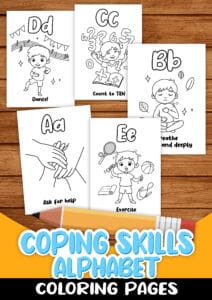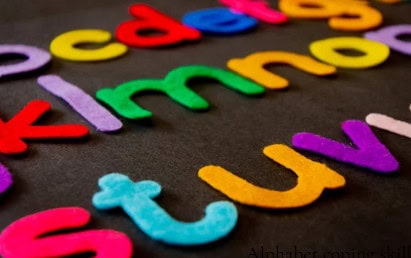Alphabet Coping Skills: A Creative Way to Teach Kids Emotional Resilience
When children experience overwhelming emotions—whether it’s frustration, sadness, or anxiety—it can be hard for them to know how to respond in a healthy way. That’s where the concept of alphabet coping skills comes in. This fun and educational method teaches a variety of simple, effective strategies for managing big emotions—one for every letter of the alphabet.
Whether you’re a parent, teacher, or counselor, the alphabet coping skills approach offers an engaging way to help kids build emotional resilience, self-awareness, and self-regulation skills. Let’s walk through the ABCs of coping, using examples from the Coping Skills Alphabet Book, and explore how you can use this tool at home or in your classroom.
What Are Alphabet Coping Skills?
Alphabet coping skills are calming or regulating techniques assigned to each letter of the alphabet. For example:
- A is for Ask for help
- B is for Breathe slowly and deeply
- C is for Count to ten
- D is for Dance
- E is for Exercise
And so on—each letter introduces a child-friendly strategy that supports emotional well-being.
This approach turns a typical learning tool (the alphabet) into a resource for mental health, empowering children with options when emotions run high. It’s especially useful for young children, visual learners, and students who need a consistent routine to manage their feelings.
Benefits of Alphabet Coping Skills
Using alphabet coping skills as part of your emotional education strategy has many benefits:
1. Makes Emotional Regulation Accessible
Children may not always have the vocabulary or self-awareness to articulate what they’re feeling. By learning coping tools through the alphabet, they associate letters with actions they can take to feel better.
2. Builds a Toolkit of Healthy Habits
Instead of defaulting to outbursts or withdrawal, children learn to reach for positive actions like journaling, hugging, or going outside.
3. Integrates Seamlessly into Learning
You can blend alphabet coping skills into literacy, art, music, or physical education activities. This keeps emotional learning fun, not overwhelming.
4. Promotes Independence
The more children practice these skills, the more they begin to self-regulate. Over time, they’ll begin choosing helpful strategies on their own.
The ABCs of Coping Skills (Highlights)
Here’s a glimpse into some of the simple yet powerful tools featured in the Coping Skills Alphabet Book:
- A – Ask for Help
Let children know it’s okay to reach out to a parent, teacher, or friend when things feel hard. - B – Breathe Slowly and Deeply
Teach deep belly breathing as a calming technique. Try “smell the flower, blow out the candle” as a fun way to visualize it. You can also grab our free shape breathing cards to help with this. - C – Count to Ten
Great for moments of frustration. Counting gives the brain a pause to reset. - F – Feel Your Feelings
Encourage kids not to stuff emotions down, but to name them and notice how they feel in the body. - G – Gratitude List
Have kids list three things they’re thankful for. Gratitude builds resilience and a positive mindset. - H – Hug
Physical touch—like a hug from a trusted adult—releases oxytocin and brings comfort. - J – Journal
Drawing or writing about thoughts can help kids process difficult emotions. - L – Laugh Out Loud
Laughter really is good medicine! Watch a funny video or tell a silly joke. - O – Origami
Folding paper focuses the mind and soothes the nervous system. - R – Read Inspirational Quotes
Positive affirmations and quotes can reframe negative thinking. - T – Talk to a Friend
Social connection is one of the best regulators of emotional distress. - U – Unplug
Taking breaks from screens helps children reconnect with themselves and their environment. - Y – Yoga
Gentle movement combined with breathing calms both the body and mind. Try our alphabet yoga cards! - Z – Zen
Create a quiet space where a child can sit, breathe, or meditate. Incorporate the calming effects of finger tracing cards for added benefits.
How to Use the Alphabet Coping Skills Book
Here are a few ideas for making the most of this creative tool:
1. Create a Coping Corner
Print and display each letter of the alphabet with its matching coping skill. Let children visit this area when they feel overwhelmed.
2. Morning or Circle Time Activity
Start the day by reviewing one coping skill. Practice it together as a group—breathe, stretch, or share a kind word.
3. Printable Workbook
Turn the Coping Skills Alphabet Book into an activity journal. Invite kids to draw or write about each strategy.
4. Alphabet Challenge
Each day, try one new coping strategy in alphabetical order. By the end of the month, children will have tried all 26!
5. Incorporate into SEL Lessons
Use this book as part of your Social Emotional Learning (SEL) curriculum to meet CASEL competencies such as self-management and relationship skills.
Why Alphabet Coping Skills Work So Well
This method works because it’s:
- Developmentally appropriate for young children
- Visually engaging and easy to remember
- Flexible enough to adapt to different learning settings
- Empowering, giving kids agency over their emotions
And perhaps most importantly, it turns emotional learning into something positive and fun.
Final Thoughts
The alphabet coping skills method is a playful and powerful way to help children navigate life’s emotional ups and downs. By building a strong foundation of tools early, we give kids the gift of emotional intelligence—something they’ll use for a lifetime.
Whether you’re a homeschooling parent, a classroom teacher, or a counselor, you’ll find the Coping Skills Alphabet Book to be a valuable resource in promoting mental wellness. Try introducing one letter each day or week, and watch your students blossom in emotional strength and confidence.
Want to try this with your kids?
Download our free Alphabet Coping Skills printable and start your journey toward emotional resilience—one letter at a time! Just enter your information below.








